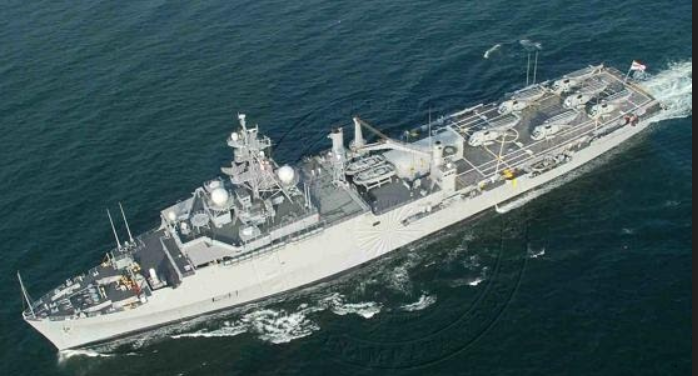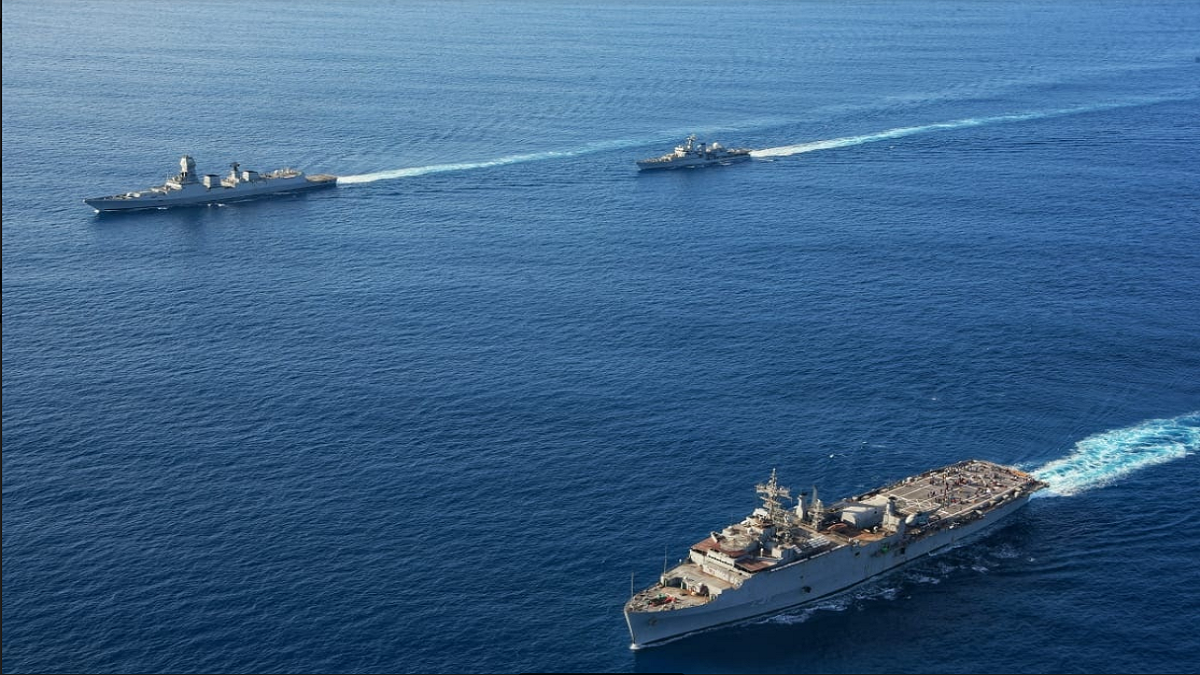Today, June 22, is the commissioning anniversary of Indian Naval Ship (INS) Jalashwa, India’s only Landing Platform Dock (LPD). Jalashwa has been in the news recently for her commendable work in evacuating stranded Indians in the Maldives and Sri Lanka as part of Operation Samudra Setu (Sea Bridge). Jalashwa’s sister ships in our Amphibious Fleet, INS Shardul, INS Kesari, INS Magar and INS Airavat, all of them Landing Ship Tanks Large (LST L), have also been contributing handsomely in evacuation of stranded Indians (more than 3,000 thus far) or as part of Mission Sagar, in delivery of Covid-related relief material in different parts of Indian Ocean, stretching from Iran to Mauritius. Elsewhere, at Port Blair, on 15 May, the Indian Navy also commissioned IN LCU (Landing Craft Utility) 57 of the latest Mark 4 class vintage.
While the range of activities in the amphibious world may elicit curiosity, the infinite variety of amphibious ships along with their tongue-twisting acronyms may often be confusing to the layperson. The anniversary of our largest amphibious ship is a good time to revisit some of the issues there and see why India needs to ramp up its ‘amph’ quotient if we wish to be a player of consequence regionally and globally. To explain in simple terms, Navies fight by either landing ordnance (missiles, guns, torpedoes and such like) on target (enemy coast, installations, ships, aircraft, submarines) using own ships, aircraft, submarines and coast batteries as the vectors or by landing ‘others’ who will then land ordnance on target.


The others include Armies, Marines, Special Forces or even specialised landing or boarding parties who are more adept at fighting on land. The ships that do this are called Amphibious Forces and have special characteristics such as the ability to hit the beach or manoeuvre close to shore to land the troops and their equipment. They also have adequate carrying capacity to embark army troops and their equipment (such as tanks, armoured vehicles, other specialist vehicles, mobile guns). Naturally, therefore, depending on their overall carrying capability of troops as well as other characteristics, the amphibious ships are classified in different categories. Also, as a separate sub-discipline of warfighting, the amphibious domain has seen several developments, doctrinally and materially, in turn leading to continuous improvisations and enhancements, tactically and technically.
Without being derailed by jargon or detail, amphibious, deriving from the word amphibian, (dictionary phrase of a creature that can inhabit both land and water), simply refers to the ability of a navy to land troops and their equipment at shores and coasts of interest, under the possible overhang of hostile conditions. Before independence, the troops of Indian Army, largely embarked on Royal Navy (RN) ships, were used in several amphibious operations, especially in both World Wars, as part of the colonial enterprise. However, the post-independence Royal Indian Navy (RIN) — we dropped the suffix Royal on January 26 1950 — had only rudimentary amphibious capabilities within a severely depleted force after partition and effects of demobilisation post World War II. Notwithstanding that, the institutional memory and recent experience of war resulted in the amphibious ships being used for Exercise Peace (Junagarh operations) wherein troops, equipment and tanks were landed in Porbandar, Mangrol and Veraval.
However, it was only in late sixties we started building up our amphibious capabilities by procuring Landing Ship Tanks (LST Medium) from Poland. A minor amphibious operation was undertaken in the 1971 war when about 600 troops along with their equipment were landed in Cox’s bazaar. In operational terms, it was not successful or particularly valuable but it taught us some important lessons. It was in Op Pawan, in late eighties, that our amphibious forces were used extensively and to good effect. This Peace Keeping Operation (PKO) in Sri Lanka lasted for three years and saw amphibious ships undertake combat beaching, logistics support, and troop and equipment transportation beside other naval operations. Amphibious forces were also used in Op Tawar (Kargil) and Op Parakram in power projection role. Our operations conducted for liberation of Goa in 1961 involving landing on Anjadip Island (Op Vijay) and in Somalia in 1994 (Op Bolster and Op Shield) when we extracted Army troops from Mogadishu can also, technically, be considered amphibious operations in hostile conditions though other type of warships were used in these endeavours.
Meanwhile, over the four decades from sixties, we progressively started building amphibious ships in India beginning with the Landing Craft Utility (LCU) and moving onto the Landing Ship Tank Large (LST L) of the Magar Class. While the LCUs are largely used for island protection and logistics support in Andaman and Nicobar and Lakshadweep and Minicoy Island chains, the LSTs are used for a variety of roles encompassing amphibious training, maritime security, defence diplomacy, training and Humanitarian Assistance and Disaster Relief (HADR) and Non Combatant Evacuation Operations (NEO).
While the HADR and NEO role will be elaborated later it would be remiss of us to think of amphibious ships only in that context. It needs emphasis that having an amphibious force provides several advantages. At the grand strategic level, amphibious capability reflects a country’s growing stature in the region and its blue water aspirations. At the strategic level, it is a good tool of deterrence. The mere fact of having the capability will often force an antagonist to think before escalating conflict. As brought out by Gen Robert H. Barrow, former Commandant, US Marine Corps, “Ever since the Phoenicians, the ability to land on defended shores have been a source of strength for those who possess it and a source of concern for those who must oppose it”. At the operational level, amphibious operations are an ‘effective method of deploying balanced forces to prevent a hostile landing, to remove an aggressive force or to support a vulnerable neighbour without actually doing anything, unless required or asked’. In other words, even as a “threat in being” it has combat potential.
A country such as ours with responsibility to protect our far flung trade routes and island territories, with a commitment to preserving peace and stability in the region, with an obligation to provide HADR to other nations with capability deficit and with a resolve to thwart several maritime security challenges from piracy to gun running and human trafficking, cannot afford to ignore the advantages of possessing adequate and up-to-date amphibious capability.
As a natural progression of this thought, India entered a select club of nations on 22 Jun 2007 when INS Jalashwa, the Landing Platform Dock (LPD) was commissioned into our Navy. The LPD is a unique kind of amphibious vessel and not many navies have them. It does not hit the beach or even come close to it, instead it contains within it organic smaller Landing Craft, which carry troops and mechanised transport (tanks, combat vehicles, trucks etc.), that are launched from the LPD far away from the coast through something called a well deck in which the well is flooded to push them out (and recover them). It is these craft which land on the beach disgorging their cargo. The LPDs also have enormous flight decks, almost the size of small aircraft carriers, from which one operates many medium or heavy helicopters that are used to carry troops or equipment for being heli-dropped thus providing an additional avenue of landing personnel and cargo.
As would be obvious to any navy man, this has several advantages. Firstly, the ship operates far off from coasts or beaches and hence the range from which combat power can be applied dramatically increases. Second, the carrying capacity of troops and tanks increases manifold when multiple Landing Craft are used. Thirdly, helicopters provide an additional vector to insert troops or cargo. Thus, LPD adds a whole new dimension to our capabilities and its induction can be considered as much a landmark event as, say, when Indian Navy entered the submarine club or missile era. In fact, a glance through Janes’ Fighting Ships might reveal lesser number of nations with LPDs than with submarines or missiles in their inventory.
That having been said, Jalashwa happened to be inducted in rather unique circumstances. In the aftermath of the 2004 Tsunami, the Indian Navy won accolades all over the world for its prompt response and resolve in providing relief and succour not only in India but abroad in Sri Lanka, Maldives and Indonesia as well. However, we realised that while we had the commitment to undertake large scale Humanitarian Assistance and Disaster Relief (HADR) operations, the means were limited. This gap between desire and delivery had to be bridged. Amphibious vessels with huge carrying capacity on the one hand and ability to land by either jetty or beach on the other are, naturally, the most suitable for HADR type of operations. So, a huge fillip had to be given to our Amphibious and HADR capability and the LPD was a natural choice. However, since LPDs cannot be built in a hurry, India decided to acquire an Austin class ship the USS Trenton along with six Sikorsky UH 3H Sea King medium lift helicopters from America and thus began the Jalashwa odyssey.
Jalashwa (Sanskrit for Sea Horse aka Hippopotamus, the powerful amphibian), thus, was a pioneer in the Indian Navy. Apart from being ourfirst LPD, she was also the first ever Indian defence buy from the USA, thus, signifying the growth in bilateral relations between nations and their navies which in time would lead to other cooperative ventures.
‘The Flying Hippo’, as she is known, is huge -at more than 170 metres long and nearly 17000 tonnes full load, she is almost similar to our first aircraft carrier Vikrant – and spacious, with cavernous troop and equipment spaces laid out in-between nine decks. A layman would be surprised by her virtuosity and forgiven for thinking of the ship only in ‘Amphibious’ terms. The vast flight deck capable of operating up to six helicopters makes her a helicopter carrier providing multidimensional capability and flexibility to the Operational Commander. A smart innovation by the Commissioning crew enabled the ship to fuel other ships in company; hence she also functions as a Fleet tanker. An advanced sensor suite and independent Flag bridge along with commodious living spaces makes her an effective Command and Control platform; advanced medical facilities including laboratory and dental chairs implies she can function as a hospital ship. Further, embarked workshop and engineering infrastructure could also enable her to act as a Fleet support vessel at sea. All these facilities together with the massive lodging space (separately for embarked troops and ship’s crew) and four Landing Craft Mechanised (LCM) each with huge carrying capacity implies that such a ship would be super effective not only in conflict but also in benign missions such as HADR or NEO or for that matter for important diplomacy/hospitality/ protocol/shop window tasking. As one defence analyst described Jalashwa “She is like a smart phone with many apps’.
While being young in our navy it needs to be remembered that the ship was born in March 1971 as USS Trenton, hence she is Indian Navy’s oldest platform. She is now “thirteen years young and forty-nine years old” combining the joie de vivre of a young teen with the depth of a mature adult. With a hull that’s still strong and with new lungs (boilers) fitted recently, the ship showcased her good health in recent operations, undertaken amidst the global pandemic of COVID-19. In the process, she also highlighted India’s unwavering commitment to safeguarding her diaspora anywhere in the world. It is noteworthy that even in her earlier incarnation as USS Trenton the ship took part in numerous humanitarian operations such as in Somalia (1991), Liberia (1996) and Lebanon (2006).
In this context, it is worth noting that in the last two decades India has been involved in several HADR and NEO operations. While some of them involved Jalashwa or other amphibious ships (such as Op Blossom in Libya and Op Samudra Setu), the others (such as Op Sukoon in Libya and Op Rahat in Yemen) did not, owing to factors such as availability, location and context. In each of these operations, Indian Navy ships performed with distinction and earned much goodwill from our international friends and global community at large.
However, without doubt, if indeed we had the required numbers of ready amphibious ships, they would have been the ships of first resort for such HADR and/or NEO missions. As brought out earlier, the enabling factors for this are huge personnel carrying capacity, long legs, greater numbers of onboard crew, inherent flexibility, hospital facilities, availability of LCMs and helicopters and large storage space for water, fuel, rations, clothes, machinery, equipment. Most importantly, all of this can be done without denuding its combat capability as an amphibious ship. Hence, no nation, which possesses amphibious ships and equipment, can ignore their value at a time of manmade or natural disaster. Here, it is worth recollecting what the Minister of Foreign Affairs of Madagascar, Djacoba Tehindrazanarivelo, wrote in the visitors’ book of INS Shardul when she was deployed there, in March this year, in response to the request for assistance by that government after massive floods, ‘Very happy to visit and meet INS Shardul and its crew and grateful to the Government and people of India for this generous donation’.
From the foregoing, it should be adequately clear to us that for the purpose of ensuring that our national interests are not threatened anywhere in our maritime areas of interest and to enable us to fulfil our responsibility as the regional net security provider, we need to have adequate numbers of large amphibious ships as part of our inventory. The vast array of our roles and responsibilities make it imperative to have certain specified force levels. The Indian Navy, in its perspective plans, had pegged these requirements at four LPDs and greater numbers of LST L and LCUs. This would necessitate either fast track indigenous production or procurement from abroad. Until then, Jalashwa and other workhorses of the amphibious force will have to do the heavy lifting.
To summarise, amphibious forces enable deterrence, influence, power projection, presence and expeditionary capability in their non-benign role and build goodwill and diplomatic equities in their benign avatar. Terms such as power projection and expeditionary must not be seen through political prism where they tend to generate unnecessary and unfounded alarm, but as technical phrases through the lens of capability. The fragile security scenario in our neighbourhood as well as the ‘messy situations’ in IOR and vicinity could necessitate several possibilities of Operations Other Than War (OOTW) occurring, where low intensity conflict, HADR and NEO conditions may manifest themselves simultaneously and concurrently. The fact that forces inimical to us are building amphibious ships and raising dedicated amphibious troops (Marines) should further reinforce these concerns.
Amphibious forces are unique political, diplomatic and strategic tools. Therefore, as a corollary, amphibious operations are both “scholarship level of military art as well as contingency plans for a situation”. More than two centuries ago, the British General in the Peninsular War, Arthur Wellesley (later the Duke of Wellington) said, “If anyone wishes to know the history of this war, I will tell them that it is our maritime superiority which gives me the power of maintaining my army while the enemy are unable to do so.” More than a century ago, Admiral of the Fleet, Lord Jackie Fisher said: “The British Army should be a projectile to be fired by the Navy.” Seventy years ago, India’s eminent maritime scholar K.M. Panikkar postulated, “Even against a dominant land power supremacy of the sea has undoubted advantages. It can land at any point of its choice, reinforce its troops, transport large masses of men continuously without fatigue and feint at distant points.” It is an advice we need to pay heed to.
Amphibious ships may not match the glamour of destroyers bristling with weapons or clip at high speed like corvettes, yet they are ‘off-beat’ and versatile. An inspiring slogan on Jalashwa’s well deck, “No land too far, no beach too hard, no task too difficult”, would be a perfect description of the “world of possibilities” they offer to higher authorities in myriad ways. They are extremely useful tools in enabling Indian Navy’s commitment to the national effort and in fulfilling Indian Government’s role as the first responder in the Indian Ocean Region.
Cmde Srikant B. Kesnur is a serving officer with interest in Indian naval history. He has also been the Commanding Officer of INS Jalashwa.









